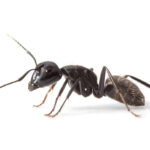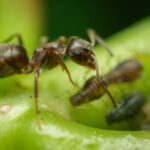How Can We Help?
Where do ants build their nests?
Ants build their nests in all sorts of places, depending on the environment and the species. Usually, ants make nests underground, creating complex tunnel systems that can go deep into the soil. These underground nests protect them from predators and extreme temperatures. You can often spot the entrance by the small mounds of displaced soil. Species like harvester ants and fire ants are famous for their extensive underground colonies.
 Some ants prefer making nests in decaying wood, like fallen logs, tree stumps, or even the wooden structures of buildings. Carpenter ants, for instance, carve out wood to create smooth, hollow galleries. Unlike termites, they don't eat the wood but remove it to expand their living space. This can cause structural damage in homes if not addressed.
Some ants prefer making nests in decaying wood, like fallen logs, tree stumps, or even the wooden structures of buildings. Carpenter ants, for instance, carve out wood to create smooth, hollow galleries. Unlike termites, they don't eat the wood but remove it to expand their living space. This can cause structural damage in homes if not addressed.
Leafcutter ants and weaver ants have unique nesting habits. Leafcutter ants build large underground nests with fungus gardens that they cultivate using leaf fragments. Weaver ants, on the other hand, make nests in trees by binding leaves together with silk produced by their larvae. These nests can form large, complex structures hanging among branches.
Certain ant species, like pavement ants, like to nest under stones, sidewalks, or other man-made structures. These spots offer a stable, warm environment and protection from the elements. Some ants also nest in natural cavities like hollow stems, acorns, or under bark.
In urban areas, ants often take advantage of human habitations, building nests inside walls, under floors, or within insulation. Moisture and food availability play a big role in where they choose to nest. For example, pharaoh ants often nest in warm, humid places like kitchens and bathrooms, while odorous house ants prefer wall voids and areas near water sources.
How deep do ant nests typically extend underground?
Ant nests vary in depth depending on the species and environmental conditions, but many extend several feet underground. On average, ant nests can reach depths of 3 to 6 feet, with some species constructing even deeper nests. For example, leafcutter ants and harvester ants are known for their extensive underground colonies that can delve 10 to 15 feet below the surface. These deep nests provide protection from predators and extreme weather conditions, ensuring a stable environment for the colony.
The depth of an ant nest is typically influenced by elements such as soil type, moisture levels, and temperature. Ants
Within these deep nests, ants create complex tunnel systems and chambers that serve various functions, such as nurseries, food storage, and resting areas. The deeper sections of the nest are often used to house the queen and brood, offering them additional protection. By extending their nests underground, ants effectively create a safe and controlled habitat, demonstrating their remarkable engineering skills and adaptability to different environmental conditions.
Do ants ever reuse or expand on existing nests?
Yes, ants often reuse or expand on existing nests, showing off their adaptability and resourcefulness. Reusing an existing nest can save energy and resources, making it a smart choice for many ant species. When a colony outgrows its current nest or needs to move due to environmental pressures or threats, it may find and occupy an abandoned nest, tweaking and expanding it to fit its needs. This behavior is especially common among species that live in highly competitive environments where prime nesting spots are hard to come by.
Expansion of existing nests is also common. As a colony grows, ants keep digging new chambers and tunnels to accommodate the increasing population and store food. For example, leafcutter ants and harvester ants are known for their extensive underground networks, which can cover large areas and have numerous interconnected chambers. These expansions are carefully planned and executed, often involving a division of labor where different ant groups specialize in digging, maintenance, and defense.
Sometimes, ants might set up satellite nests or secondary colonies near the main nest. This behavior, called polytomy, allows the colony to tap into multiple food sources and optimise resource distribution. Argentine ants and pharaoh ants frequently establish such satellite nests linked by trails that make communication and resource sharing between nests easy.
Ants also show remarkable creativity in enhancing their nests. For instance, weaver ants use silk produced by their larvae to bind leaves together, creating intricate nests in trees. Similarly, some species might incorporate materials like pebbles, plant matter, or even human debris into their nests to bolster structures or regulate temperature and humidity.
How do ants construct the intricate tunnels and chambers within their nests?

The layout of these tunnels and chambers isn't random; it's designed to meet the colony's needs. Tunnels provide efficient pathways for moving around and transporting food and brood. Chambers have various uses, like nurseries for the young, storage for food, and resting areas for workers. The nest structure also helps with ventilation and regulating temperature and humidity, ensuring a comfy living space.
Division of labor is key in this process. Different groups of worker ants focus on specific tasks, like digging, moving soil, and maintaining the nest. Some workers reinforce the tunnel walls with saliva or other secretions that harden the soil, adding stability and preventing collapses.
Communication is crucial for coordinating construction. Ants use pheromones to mark paths and highlight areas needing work. This chemical communication ensures that all workers follow a cohesive plan and adjust their activities based on what the colony needs at the moment. Additionally, ants exhibit stigmergy, where the actions of one inspire others to do similar tasks, creating a self-organizing system that leads to complex nest architecture.
Ants also adapt their construction techniques based on environmental clues. For example, in sandy soils, they might dig deeper tunnels to prevent collapse, while in clayey soils, they'll create more elaborate and interconnected chambers.
Through a mix of individual actions, teamwork, and adaptive building strategies, ants are able to create sophisticated and efficient tunnels and chambers. This impressive engineering feat reflects their social organization and evolutionary smarts.
Hiring professionals like us here at Youngs Pest Control will not only give you peace of mind, but it will also help ensure that your ant problems are swiftly and effectively dealt with. Our team of experts has the knowledge and tools to identify and eliminate any ant infestations, keeping your home or business pest-free. Don't hesitate to contact us for all your pest control needs!
